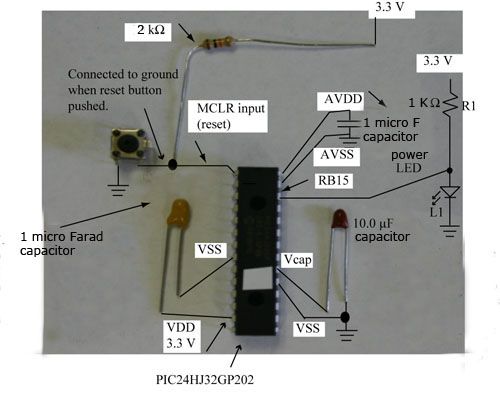Preparation
In addition to the power supply that you created on your breadboard in Lab 2, you will need the following equipment/components to complete your PIC prototype board:
- (1) multimeter
- (1) PIC 24HJ32GP202 chip
- (2) alligator clip leads
- (1) LED
- (1) 1K Ohm resistor
- (1) 2 K or 2.2 K Ohm resistor
- (1) 10 micro Farad capacitor
- (2) 1 micro Farad capacitors
- (1) pushbutton switch
- (1) power switch
- (1) 6 pin header
- (1) FTDI TTL-232R-3.3V USB-to-serial cable
- (1) 6V wall transformer
- (1) power connector
- single-strand wire as needed
Part 0: Background
In this lab, you will build a prototype PIC system on your breadboard and test it. You’ll begin by modifying the 3.3V power supply that you built on your breadboard in Lab 2.
Part 1: Modifying your 3.3V Power Supply
The circuit that you built in lab 2 is depicted below. Make sure that you note any deviations between the schematic below and your breadboard. For example, several of you may have “lost” your fuse and have replaced it with a wire. It’s important replace the fuse, and any missing components, in the final PIC system created today. Also make sure that your resistor and capacitors match the specifications stated below.
The power connector and wall transformer
Locate the power connector and wall transformer shown below.
Plug the power connector into the wall transformer and use your multimeter to determine which two pins on the power connector provide +6 V and ground as shown below. Each power connector has three leads, but only two are used.
SOLDER wires to the power connector, and connect this to the power/ground posts on the breadboard as shown below. The ground post is connected to the ground rail, but the +6 V power post connects to the input power switch which will be installed next.
Use the multimeter to verify that you are receiving 6 Volts of power at the connections to the breadboard before proceeding.
The input power switch
The input power switch allows you to isolate your system from the wall transformer without disconnecting wires. Our switch is a single-pole double-throw slide switch, which in simple English means that the center pin (the pole) is always connected to one of the two outer pins, and that connection is determined by the position of the slide on the top of the switch.
Connect the input power (from the power connector) to one of the outer pins of the switch, and the fuse to the pole. Verify your connection by properly positioning the switch and seeing that your power light illunimates.
The 6-pin header
As our final modification to the power supply, we’ll connect a 6-pin header to the board and wire it to the power switch and to ground as shown below. The figure below represents our complete board layout up to this point.
For more detail: CSCI 255 Lab


